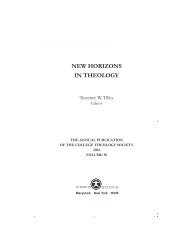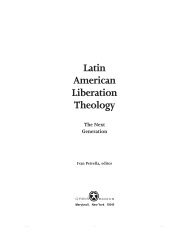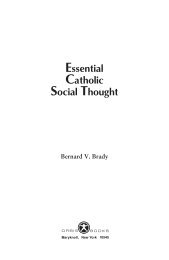CONCEPTS OF MISSION - Orbis Books
CONCEPTS OF MISSION - Orbis Books
CONCEPTS OF MISSION - Orbis Books
You also want an ePaper? Increase the reach of your titles
YUMPU automatically turns print PDFs into web optimized ePapers that Google loves.
Mission in Contemporary Missiology 33<br />
for-us,” which amounts to his being a symbol of a God who is benevolent<br />
toward all humanity, especially the oppressed. This Christological position<br />
stands in the tradition of the great prophets of Israel in their efforts to<br />
denounce injustice and institute a truly just society. In this view Christ is distinguished<br />
by his solidarity with others in the face of worldly powers. As<br />
such, there is little to criticize and much to praise in retrieving this man-forothers<br />
and prophetic dimension. Indeed there is much to praise. But orthodoxy,<br />
tutored by the early Trinitarian councils and creeds, asks, “Is this all<br />
the Scriptures and tradition record”<br />
Some authors arrive at completely secular and radical conclusions: God<br />
and transcendence are eliminated in favor of a unidimensional, “horizontal”<br />
Christian atheology. The message of Christ in this case is to be interpreted<br />
only when we have the human being as the background. Christ was a free<br />
man, who preached liberation and who liberates humankind. Thus, the figure<br />
of Christ is reduced to a model in the struggle for liberation, for work in<br />
favor of others—and these are the new focus for mission. Other authors<br />
more theological in approach see in Christ the normative means but not the<br />
constitutive element of salvation. It seems fair to say, too, that in this understanding<br />
salvation is viewed primarily in this-worldly, historical, and<br />
sociopolitical liberationist terms, not as an eschatological event in which we<br />
participate now but anticipate the fullness thereof at the parousia.<br />
To evaluate such trends in Christology, we need to begin by looking at<br />
the mission of Christ in the New Testament. There he is portrayed as the<br />
definitive missionary who was sent by the Father for the salvation of all and<br />
who has communicated this mission to the church. From the moment of its<br />
inception, the church kept in mind this view, as one sees in texts such as<br />
“There is no salvation in any other name” (Acts 4:12), and no other mediator<br />
“between God and humankind” (1 Tim 2:4-6). Furthermore, in very clear<br />
terms, Christ describes himself as the life, the truth, and the way (John 10:6).<br />
As we said above, John Paul II in Redemptoris Missio points out the inadequacies<br />
of such theories in contemporary Christology and affirms that Jesus<br />
the Christ is the foundation of the church’s internal life and of all her activities,<br />
and Jesus is the reason for its most essential activity, the mission ad<br />
gentes (RM 4). Furthermore, since salvation is possible only in and through<br />
Christ in whom God revealed himself, and since he is the Word, he is also the<br />
unique, universal, and absolute savior (RM 5-6). Thus, Christ must be proclaimed<br />
to those who do not yet know him (RM 9-11). John Paul II’s insistence<br />
on the uniqueness of Christ, however, as mediator does not exclude<br />
other “participated forms of mediation of different kinds and degrees”; but<br />
these “acquire meaning and value only from Christ’s own mediation, and<br />
they cannot be understood as parallel or complementary to his” (RM 5).<br />
Christ is the only mediator between God and humanity; all the other great<br />
founders of religions can be considered mediators only in relationship with<br />
and in the power of Christ (LG 62; RM 5; DI 13-15).
















